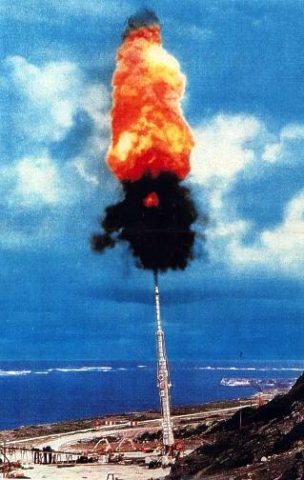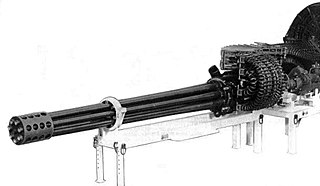Related Research Articles

Nuclear artillery is a subset of limited-yield tactical nuclear weapons, in particular those weapons that are launched from the ground at battlefield targets. Nuclear artillery is commonly associated with shells delivered by a cannon, but in a technical sense short-range artillery rockets or tactical ballistic missiles are also included.

Project HARP, short for High Altitude Research Project, was a joint venture of the United States Department of Defense and Canada's Department of National Defence created with the goal of studying ballistics of re-entry vehicles and collecting upper atmospheric data for research. Unlike conventional space launching methods that rely on rockets, HARP instead used very large guns to fire projectiles into the atmosphere at extremely high speeds.

A mortar is usually a simple, lightweight, man-portable, muzzle-loaded weapon, consisting of a smooth-bore metal tube fixed to a base plate with a lightweight bipod mount and a sight. They launch explosive shells in high-arcing ballistic trajectories. Mortars are typically used as indirect fire weapons for close fire support with a variety of ammunition.

A shell, in a military context, is a projectile whose payload contains an explosive, incendiary, or other chemical filling. Originally it was called a bombshell, but "shell" has come to be unambiguous in a military context. Modern usage sometimes includes large solid kinetic projectiles, which are more properly termed shot. Solid shot may contain a pyrotechnic compound if a tracer or spotting charge is used.

The General Electric GAU-8/A Avenger is a 30 mm hydraulically driven seven-barrel Gatling-style autocannon that is primarily mounted in the United States Air Force's Fairchild Republic A-10 Thunderbolt II. Designed to destroy a wide variety of ground targets, the Avenger delivers very powerful rounds at a high rate of fire. The GAU-8/A is also used in the Goalkeeper CIWS ship weapon system, which provides defense against short-range threats such as highly maneuverable missiles, aircraft, and fast maneuvering surface vessels. The GAU-8/A is currently produced by General Dynamics.

The M687 was an American 155 mm binary sarin chemical artillery shell. The design was standardized in 1976 and production began on December 16, 1987 at Pine Bluff Arsenal, Pine Bluff, Arkansas. Production was halted three years later, following the 1990 Chemical Weapons Accord between the United States and the USSR, and the dismantling of existing stocks began in November 1997 at Hawthorne Army Depot, Nevada. America's remaining stocks were stored at the Deseret Chemical Depot, Utah, and the Umatilla Chemical Depot.
This article explains terms used for the British Armed Forces' ordnance (weapons) and ammunition. The terms may have slightly different meanings in the military of other countries.

The Pine Bluff Arsenal is a United States Army installation in Jefferson County, Arkansas, about eight miles northwest of Pine Bluff and thirty miles southeast of Little Rock.

The W48 was an American nuclear artillery shell, capable of being fired from any standard 155-millimetre (6.1 in) howitzer. A tactical nuclear weapon, it was manufactured starting in 1963, and all units were retired in 1992. It was known as the XM454 AFAP in US service.

The W33 was an American nuclear artillery shell designed for use in the 8-inch (203 mm) M110 howitzer and M115 howitzer.
A dynamite gun is any of a class of artillery pieces that use compressed air to propel an explosive projectile. Dynamite guns were in use for a brief period from the 1880s to the beginning of the twentieth century.
The Long Range Land Attack Projectile (LRLAP) is a canceled precision guided 155 mm naval artillery shell for the U.S. Navy's Advanced Gun System (AGS). LRLAP was developed and produced by Lockheed Martin Missiles and Fire Control, the prime contractor being BAE Systems.

The 6-inch/47 caliber Mark 16 gun was used in the main batteries of several pre-war and World War II US Navy light cruisers. They were primarily mounted in triple turrets and used against surface targets. The Mark 16DP gun was a dual purpose fitting of the Mark 16 for use against aircraft as well as surface ships. It was installed in the post-war Worcester-class light cruisers and the anti-aircraft gunnery training ship Mississippi.
The BLU-80/B BIGEYE bomb was a developmental U.S. air-launched binary chemical weapon. The BIGEYE was a 500-pound (230 kg) class glide bomb with a radar altimeter fuze intended to disperse the binary generated nerve agent VX, made in flight from the non-lethal chemical components "QL" and sulfur only after aircraft release. The BLU-80-B was designed under the auspices of the U.S. Navy as a safe chemical weapons alternative in response to chemical weapons (CW) threats from the USSR and other actors. BIGEYE was a genuine tri-service program led by the U.S. Navy with significant U.S. Army and U.S. Air Force participation. Initially approved in the 1950s, the program persisted into the 1990s.
The M121/A1 155mm Projectile was a chemical artillery shell designed for use by the U.S. Army. It was designed to be used with approximately 6.5 lb (2.9 kg) of GB or VX nerve agents.
The M426 8-inch shell was a 203 mm (8.0 in) chemical artillery shell designed for use by the U.S. Army. It was designed to be used with approximately 14.5 lb (6.6 kg) of GB or VX.

The last chemical weapon in the U.S. stockpile was destroyed July 7, 2023, at the Blue Grass Chemical Agent-Destruction Pilot Plant.

The 3-inch ordnance rifle, model 1861 was a wrought iron muzzleloading rifled cannon that was adopted by the United States Army in 1861 and widely used in field artillery units during the American Civil War. It fired a 9.5 lb (4.3 kg) projectile to a distance of 1,830 yd (1,670 m) at an elevation of 5°. The 3-inch rifle was not as effective in firing canister shot as the heavier 12-pounder Napoleon, but it proved to be highly accurate at longer ranges when firing common shell or spherical case shot. There was only one reported case of a 3-inch ordnance rifle bursting in action. This was in stark contrast to the similarly-sized cast iron 10-pounder Parrott rifles which occasionally burst without warning, inflicting injury on the gun crews. The Confederate States of America lacked the technology to manufacture reliable copies of the 3-inch ordnance rifle. However, the Confederate States Army respected the weapons and employed those captured from Federal forces.

SAM-N-8 Zeus, also known as Zeus I, was a project by the Naval Ordnance Laboratory of the United States Navy to develop a guided anti-aircraft artillery shell for launch from 8-inch (200 mm) guns. Tested in the late 1940s, it was overtaken by advances in guided missile technology.
References
- ↑ Adams, Robert W. "CHEMICAL WARFARE IN FUTURE MILITARY OPERATIONS", Command and Staff College, United States Navy, via Globalsecurity.org, April 6, 1984, accessed January 3, 2009.
- 1 2 D'Amico, William P., Jr. "Comments on the Flight Stability of the XM736 8-Inch Binary Projectile", (Abstract/Citation), October 1982, accessed January 3, 2009.